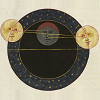Retraduction, réaccentuation, redialogisation : stratégies éditoriales et stratégies de traduction dans les traductions néerlandaises des Liaisons dangereuses
DOI :
https://doi.org/10.51777/relief10828Mots-clés :
retraduction, Choderlos de Laclos, stratégies de traduction, réceptionRésumé
Étudier ce qui se passe lorsqu’un classique est traduit ou, a fortiori, retraduit – en l’occurrence Laclos en néerlandais – implique que l’on envisage les traductions comme autant d’étapes dans le processus historique de réinterprétation continue des classiques, que Bakhtine appelait « réaccentuation ». En nous appuyant sur ce concept, nous analyserons les stratégies éditoriales et de traduction employées, afin de montrer comment les premières traductions néerlandaises réaccentuent le matériau linguistique et littéraire des Liaisons dangereuses vers une interprétation moderne et conventionnalisée du libertinage. La dernière traduction, par contre, offre une interprétation davantage historisante, tout en dialogisant la langue, moins conventionnelle, plus hétéroglossique. En cela, cette dernière traduction redialogise les traductions antérieures, c’est-à-dire les réintroduit dans la « seconde ligne stylistique » du roman, autant qu’elle réaccentue le texte de Laclos dans la culture d’arrivée néerlandophone.
Téléchargements

Téléchargements
Publié
Numéro
Rubrique
Licence
© Kris Peeters 2021

Cette œuvre est sous licence Creative Commons Attribution 4.0 International.
Tous les articles dans RELIEF sont publiés en libre accès sous la licence Creative Commons Attribution 4.0 International License (CC-BY 4.0). Sous ce régime les auteurs conservent les droits d'auteur mais ils consentent à toute sorte d'utilisation de leur texte pourvu qu'il soit correctement cité.








